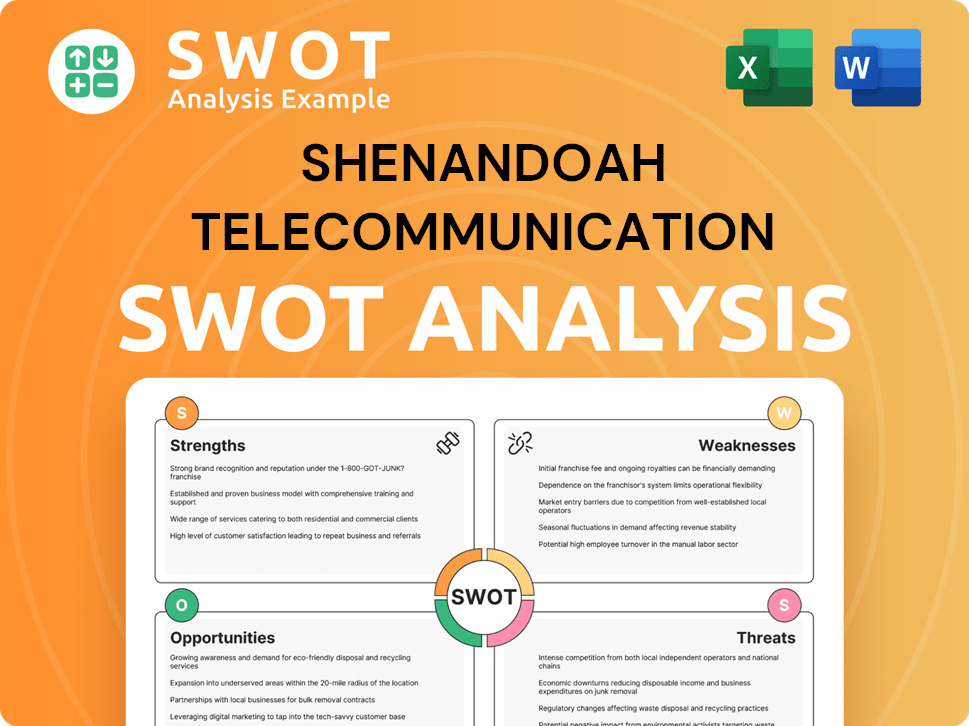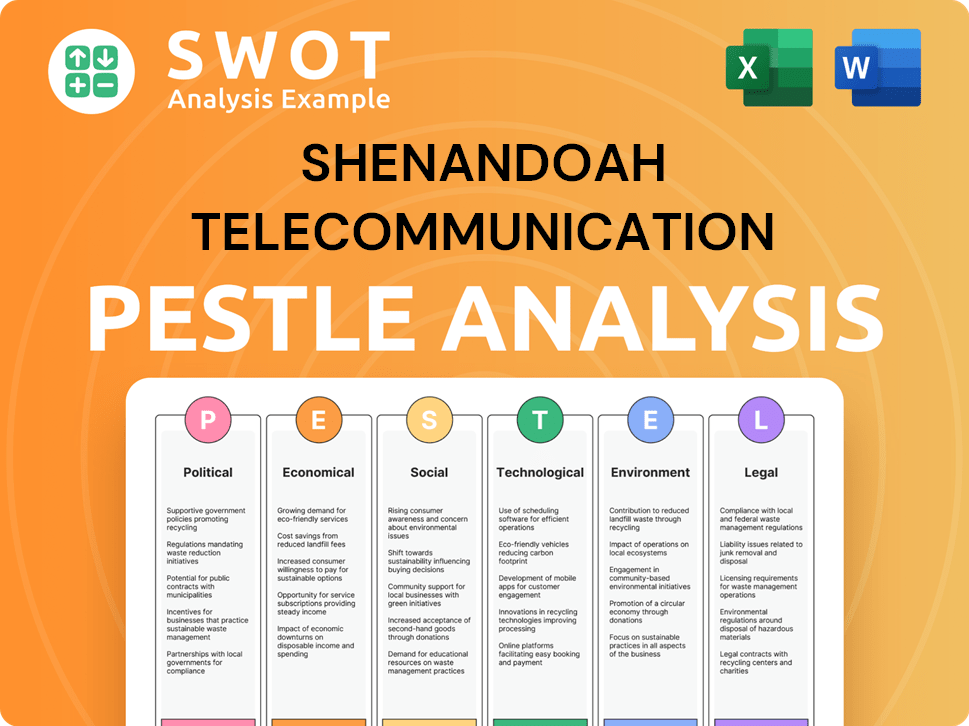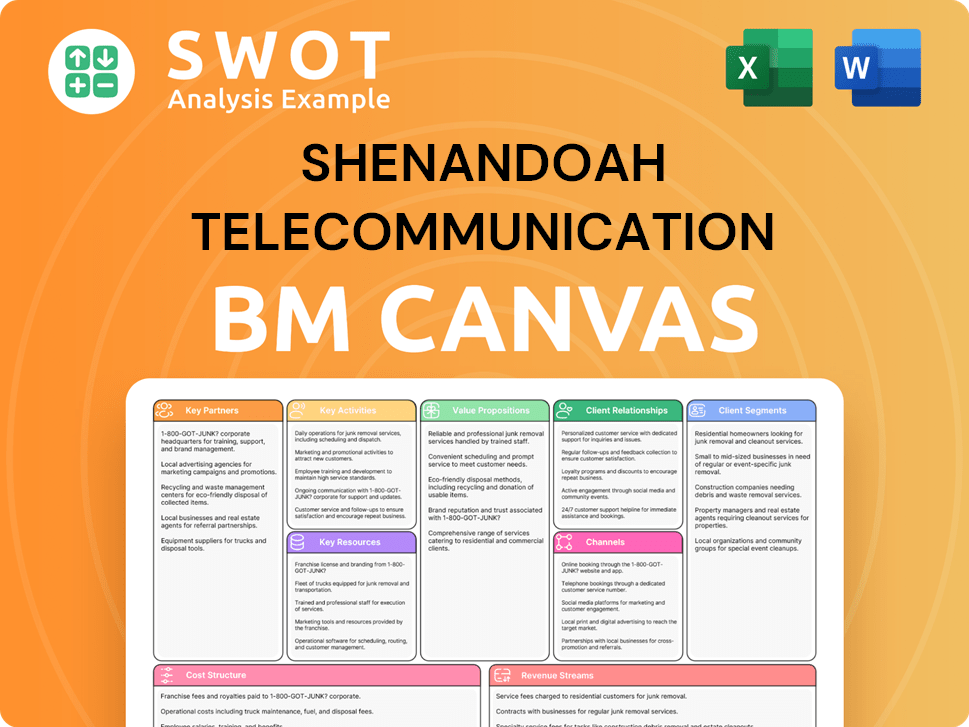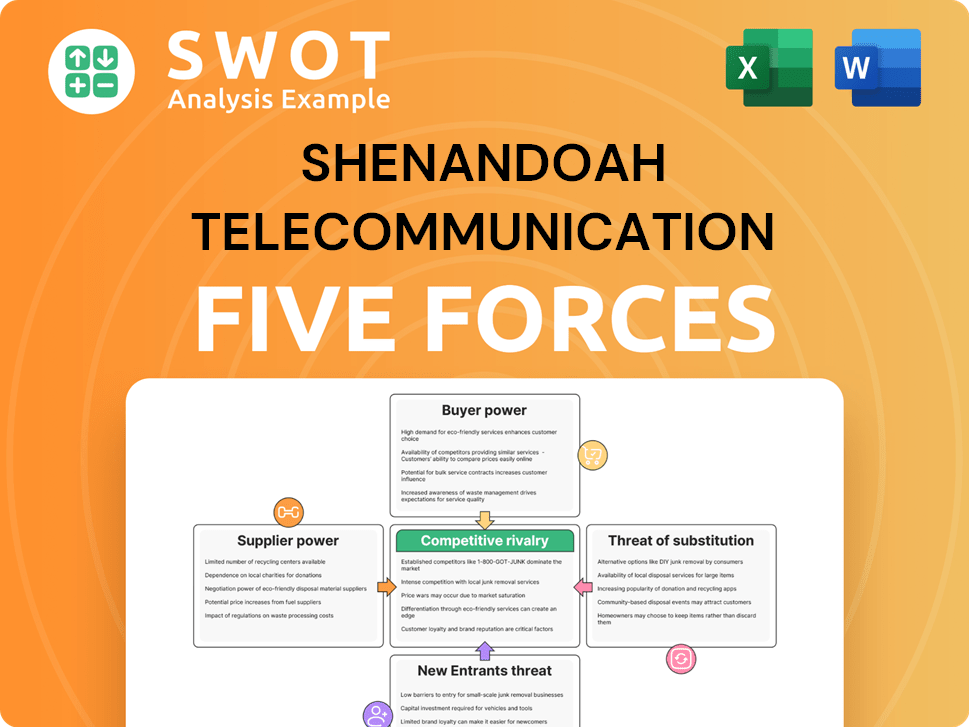Shenandoah Telecommunication Bundle
How Does Shenandoah Telecommunications Stack Up in Today's Telecom Wars?
In a telecommunications industry defined by relentless innovation and fierce competition, understanding the Shenandoah Telecommunication SWOT Analysis is crucial for any investor or strategist. This report dives deep into Shentel's competitive landscape, exploring its historical roots and its evolution into a modern telecommunications powerhouse. We'll dissect its market position, scrutinize its rivals, and assess its unique strengths.

From its early days serving rural Virginia to its current status as a publicly traded company, Shentel's journey offers valuable insights for Shentel market analysis. This comprehensive analysis will examine Shentel's main competitors and evaluate Shentel's strengths and weaknesses within the telecommunications industry. By evaluating Shentel's competitive advantages and recent acquisitions, we aim to provide a clear picture of Shenandoah Telecommunications and its future prospects, including Shentel's future growth strategies.
Where Does Shenandoah Telecommunication’ Stand in the Current Market?
The core operations of Shentel, focusing on the telecommunications industry, center on providing broadband services. Their value proposition emphasizes high-speed internet through fiber optic and cable networks, primarily serving smaller markets and rural communities across eight states in the eastern United States. This strategic focus allows Shentel to leverage its extensive regional network and establish a strong position in underserved areas.
Shentel's approach to the Growth Strategy of Shenandoah Telecommunication involves building and expanding its fiber-optic infrastructure, particularly through its Glo Fiber initiative. This expansion targets increased data subscriber numbers and revenue growth in key markets. The company's financial performance reflects these strategic initiatives, with notable revenue increases and a focus on enhancing its network capabilities.
In Q1 2025, Shentel reported a total revenue of $87.9 million, marking a 26.9% increase year-over-year. This growth was significantly influenced by the Horizon acquisition, which contributed $15.2 million. Excluding the acquisition, revenue still grew by 5% to $72.9 million. The Glo Fiber Expansion Markets saw a 51% increase in data subscribers, reaching approximately 71,000, and revenue from these markets grew by 52% to $18.4 million. Shentel aims to reach 440,000 Glo Fiber passings by the end of 2025 and approximately 550,000 by the end of 2026. Despite a net loss of $9.1 million in Q1 2025, Adjusted EBITDA grew by 43.3% to $27.6 million, indicating strong operational performance. As of March 31, 2025, total available liquidity was approximately $334.6 million.
Shentel strategically targets smaller markets and rural communities. This niche focus allows the company to concentrate its resources and build a strong presence in areas often underserved by larger competitors. This approach supports its growth strategy.
The Glo Fiber initiative is a key driver of Shentel's growth. This expansion includes increasing data subscribers and revenue in the expansion markets. The company is committed to expanding its fiber network to reach more homes and businesses.
Shentel's financial performance in Q1 2025 showed a significant increase in revenue. The company's Adjusted EBITDA growth indicates strong operational efficiency. The Horizon acquisition has played a key role in revenue growth.
Shentel maintains a solid financial position with substantial available liquidity. This financial strength supports investments in network expansion and service enhancements. The company's focus on growth is backed by its financial resources.
Shentel's market position is defined by its focus on broadband services and strategic expansion. The company's financial results reflect its growth initiatives and operational efficiency. These factors contribute to its competitive standing in the telecommunications industry.
- Targeting smaller markets and rural areas.
- Expanding fiber network through the Glo Fiber initiative.
- Achieving significant revenue growth, particularly in expansion markets.
- Maintaining strong liquidity to support growth and investments.
Shenandoah Telecommunication SWOT Analysis
- Complete SWOT Breakdown
- Fully Customizable
- Editable in Excel & Word
- Professional Formatting
- Investor-Ready Format

Who Are the Main Competitors Challenging Shenandoah Telecommunication?
The Shentel competitive landscape is shaped by a diverse array of telecommunications providers. These competitors range from large national corporations to regional players, each vying for market share in the broadband, wireless, and video services sectors. Understanding these competitors is crucial for assessing Shentel market analysis and its strategic positioning within the telecommunications industry.
Shentel faces competition in its core markets, particularly in broadband. The company's geographic focus and service offerings are key differentiators, but the presence of larger competitors and the ongoing shift towards fiber-to-the-home technology create a dynamic environment. This chapter provides a detailed look at Shentel's main competitors and the competitive pressures it faces.
Shentel operates in a competitive telecommunications market, facing both direct and indirect rivals. The company's primary competitors include large national and regional players. Some of Shentel's notable competitors include WideOpenWest, Consolidated Communications, Altice USA, Verizon Communications, Comcast, and T-Mobile. While some of these competitors are significantly larger in terms of revenue and employee count, Shentel distinguishes itself by focusing on its specific geographic footprint and service offerings.
Verizon, a major competitor, offers a broad range of services and extensive network coverage. With a trailing 12-month revenue of approximately $134.8 billion, Verizon's scale and resources pose a significant challenge to Shentel. Verizon's extensive infrastructure and service offerings allow it to compete aggressively in both urban and rural markets.
Comcast is another major player in the broadband services market, competing directly with Shentel in various regions. Comcast's strong presence in the cable industry and its focus on bundled services provide a competitive edge. Comcast's market share and aggressive pricing strategies put pressure on Shentel's customer acquisition and retention efforts.
T-Mobile competes with Shentel, particularly in wireless services. T-Mobile's aggressive expansion and competitive pricing strategies challenge Shentel's wireless offerings. The wireless market is highly competitive, with T-Mobile continually investing in its network and service offerings to gain market share.
Altice USA, a cable and telecommunications company, competes with Shentel in broadband and video services. Altice USA's focus on providing high-speed internet and advanced video services challenges Shentel's market position. The company's ability to bundle services and offer competitive pricing puts pressure on Shentel.
Consolidated Communications, a regional telecommunications provider, competes with Shentel in several markets. Consolidated Communications' focus on providing broadband, voice, and data services to both residential and business customers challenges Shentel's market share. The company's infrastructure investments and service offerings contribute to the competitive landscape.
WideOpenWest (WOW!) is a competitor in the broadband market, offering high-speed internet and other services. WOW!'s focus on providing competitive pricing and advanced services challenges Shentel's customer base. The company's ability to innovate and adapt to market changes influences the competitive dynamics.
The competitive pressures on Shentel are particularly evident in its incumbent broadband markets, where approximately 20% of its passings face competition from other broadband providers, including cable or fiber competitors. This competition can lead to subscriber losses in certain segments, as seen with a decline in data customers in incumbent broadband markets. The company's recent acquisition of Horizon Telcom is expected to yield $13.8 million in annual synergy savings by Q2 2025, which is a strategic move to strengthen its market position. The shift towards fiber-to-the-home technology by various providers further intensifies the competition for high-speed internet customers. For a deeper dive into Shentel's strategy, consider reading about Shentel's strategic initiatives.
Several factors influence the competitive landscape for Shentel and its rivals.
- Network Infrastructure: The quality and reach of network infrastructure, including fiber-optic and wireless networks, are critical.
- Service Offerings: The range and quality of services, including broadband speeds, video options, and wireless plans, are key differentiators.
- Pricing Strategies: Competitive pricing and bundled service packages are important for attracting and retaining customers.
- Customer Service: The level of customer service and support influences customer satisfaction and loyalty.
- Technological Innovation: The adoption of new technologies, such as fiber-to-the-home and 5G, affects competitiveness.
Shenandoah Telecommunication PESTLE Analysis
- Covers All 6 PESTLE Categories
- No Research Needed – Save Hours of Work
- Built by Experts, Trusted by Consultants
- Instant Download, Ready to Use
- 100% Editable, Fully Customizable

What Gives Shenandoah Telecommunication a Competitive Edge Over Its Rivals?
The competitive advantages of Shenandoah Telecommunications (Shentel) are rooted in its strategic focus and operational excellence within the telecommunications industry. A key element of its success is targeting smaller markets and rural communities, an area often overlooked by larger providers. This approach is bolstered by government initiatives aimed at expanding fiber infrastructure into underserved areas, which Shentel actively pursues.
The company's strategic moves, including the aggressive expansion of its Glo Fiber network, have significantly enhanced its market position. This expansion has led to substantial growth in data subscribers and revenue, particularly in its Glo Fiber Expansion Markets. Furthermore, Shentel's commitment to straightforward pricing and customer-centric service fosters customer loyalty in its target markets. For a deeper understanding of Shentel's mission and growth strategy, consider reading Growth Strategy of Shenandoah Telecommunication.
These factors, combined with a robust fiber network and strategic acquisitions, position Shentel favorably in the Shentel competitive landscape. The focus on fiber-first strategy and underserved areas addresses a persistent market need and benefits from ongoing infrastructure development, reinforcing its competitive edge.
The Glo Fiber network is a key differentiator, offering symmetrical, multi-gigabit service. Shentel plans to reach 550,000 Glo Fiber passings by the end of 2026, demonstrating its commitment to infrastructure. The company's established regional network includes over 16,800 route miles of fiber, providing a robust infrastructure.
Glo Fiber Expansion Markets saw a 51% increase in data subscribers to approximately 71,000 in Q1 2025 and a 52% revenue growth. Mature fiber markets show strong profitability, with some cohorts reaching 40% penetration and achieving free cash flow margins exceeding 40%. This underscores the long-term value of Shentel's fiber investment.
Shentel emphasizes straightforward pricing with no long-term contracts. The company also focuses on prompt and friendly local customer service. This approach fosters customer loyalty in its target markets.
Shentel leverages acquisitions, such as Horizon Telcom, to drive revenue growth and achieve synergy savings. This strategic agility supports the company's overall growth and market expansion. These acquisitions enhance Shentel's capabilities and market reach.
The Shentel competitive landscape is shaped by several key advantages. These include a focus on underserved markets, an extensive fiber network, and a customer-centric approach. These elements contribute to Shentel's strengths and weaknesses.
- Strategic focus on smaller markets and rural communities.
- Aggressive expansion of the Glo Fiber network with multi-gigabit service.
- Emphasis on straightforward pricing and local customer service.
- Leveraging acquisitions to drive revenue growth and achieve synergy savings.
Shenandoah Telecommunication Business Model Canvas
- Complete 9-Block Business Model Canvas
- Effortlessly Communicate Your Business Strategy
- Investor-Ready BMC Format
- 100% Editable and Customizable
- Clear and Structured Layout

What Industry Trends Are Reshaping Shenandoah Telecommunication’s Competitive Landscape?
The telecommunications industry is experiencing significant transformation, driven by technological advancements, evolving consumer preferences, and regulatory shifts. This dynamic landscape presents both challenges and opportunities for companies like Shenandoah Telecommunications (Shentel). Understanding the Shentel competitive landscape is crucial for investors and stakeholders seeking to make informed decisions in this evolving market.
Shentel's market analysis reveals a company navigating a sector marked by intense competition and rapid technological change. The company is focused on strategic investments and operational efficiencies to maintain its market position. The future outlook hinges on successful execution of its fiber expansion plans and adaptability to evolving industry dynamics.
The telecommunications industry is seeing a rise in 5G technology, expected to be the dominant standard for smartphones in 2025. Fixed Wireless Access (FWA) and the integration of generative AI into smartphones are also key trends. Telecom providers are prioritizing modernization to enhance operational efficiency and customer experience.
Shentel can capitalize on the growing demand for high-speed, reliable internet through its fiber expansion, particularly with its Glo Fiber network. The increase in data usage and online streaming services creates opportunities to grow its broadband subscriber base. The company plans to reach 550,000 Glo Fiber passings by the end of 2026.
Elevated capital expenditures for network expansion are a concern, with plans for $250 million to $280 million in net investments throughout 2025. Competitive pressures in existing markets and the termination of government-subsidized programs like the Affordable Connectivity Program are also challenges. Regulatory changes could impact pricing.
Shentel anticipates becoming free cash flow positive by 2027, supported by projected EBITDA margin growth. The company is focused on managing churn and increasing average revenue per user (ARPU) through new pricing plans. Strategic partnerships and acquisitions are also key to its growth strategy. Read more about the Target Market of Shenandoah Telecommunication.
Shentel's competitive position is evolving, with a focus on fiber expansion, operational efficiency, and customer value. The company aims to navigate the dynamic telecommunications landscape through strategic investments and operational improvements.
- Fiber Expansion: Shentel's Glo Fiber expansion is a key strategy to capitalize on the demand for high-speed internet.
- Financial Goals: The company aims to be free cash flow positive by 2027.
- Strategic Initiatives: Focus on managing churn and growing ARPU through new pricing plans.
- Market Dynamics: Navigating competitive pressures and regulatory changes is crucial for Shentel's success.
Shenandoah Telecommunication Porter's Five Forces Analysis
- Covers All 5 Competitive Forces in Detail
- Structured for Consultants, Students, and Founders
- 100% Editable in Microsoft Word & Excel
- Instant Digital Download – Use Immediately
- Compatible with Mac & PC – Fully Unlocked

Related Blogs
- What are Mission Vision & Core Values of Shenandoah Telecommunication Company?
- What is Growth Strategy and Future Prospects of Shenandoah Telecommunication Company?
- How Does Shenandoah Telecommunication Company Work?
- What is Sales and Marketing Strategy of Shenandoah Telecommunication Company?
- What is Brief History of Shenandoah Telecommunication Company?
- Who Owns Shenandoah Telecommunication Company?
- What is Customer Demographics and Target Market of Shenandoah Telecommunication Company?
Disclaimer
All information, articles, and product details provided on this website are for general informational and educational purposes only. We do not claim any ownership over, nor do we intend to infringe upon, any trademarks, copyrights, logos, brand names, or other intellectual property mentioned or depicted on this site. Such intellectual property remains the property of its respective owners, and any references here are made solely for identification or informational purposes, without implying any affiliation, endorsement, or partnership.
We make no representations or warranties, express or implied, regarding the accuracy, completeness, or suitability of any content or products presented. Nothing on this website should be construed as legal, tax, investment, financial, medical, or other professional advice. In addition, no part of this site—including articles or product references—constitutes a solicitation, recommendation, endorsement, advertisement, or offer to buy or sell any securities, franchises, or other financial instruments, particularly in jurisdictions where such activity would be unlawful.
All content is of a general nature and may not address the specific circumstances of any individual or entity. It is not a substitute for professional advice or services. Any actions you take based on the information provided here are strictly at your own risk. You accept full responsibility for any decisions or outcomes arising from your use of this website and agree to release us from any liability in connection with your use of, or reliance upon, the content or products found herein.